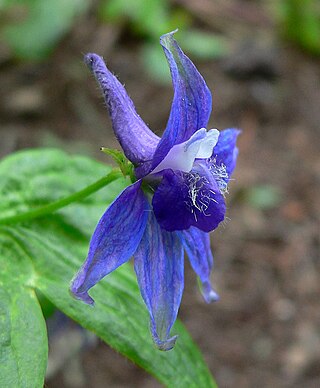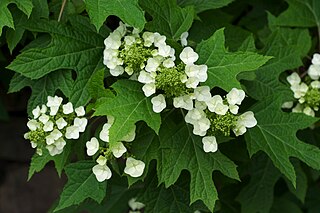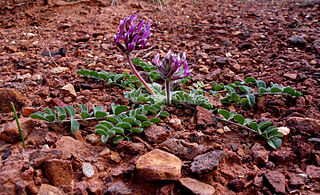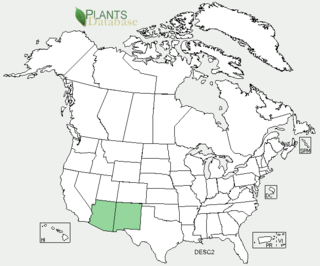
Delphinium is a genus of about 300 species of annual and perennial flowering plants in the family Ranunculaceae, native throughout the Northern Hemisphere and also on the high mountains of tropical Africa. The genus was erected by Carl Linnaeus.

Habitat fragmentation describes the emergence of discontinuities (fragmentation) in an organism's preferred environment (habitat), causing population fragmentation and ecosystem decay. Causes of habitat fragmentation include geological processes that slowly alter the layout of the physical environment, and human activity such as land conversion, which can alter the environment much faster and causes the extinction of many species. More specifically, habitat fragmentation is a process by which large and contiguous habitats get divided into smaller, isolated patches of habitats.

Delphinium bakeri, or Baker's larkspur, is a species of perennial herb in the buttercup family, Ranunculaceae. It is endemic to California in the United States, where it is a federally listed endangered species. It is known in the wild from one remaining occurrence near Salmon Creek in Sonoma County, where only seven plants remained as of March 2006.

Wildlife conservation refers to the practice of protecting wild species and their habitats in order to maintain healthy wildlife species or populations and to restore, protect or enhance natural ecosystems. Major threats to wildlife include habitat destruction, degradation, fragmentation, overexploitation, poaching, pollution, climate change, and the illegal wildlife trade. The IUCN estimates that 42,100 species of the ones assessed are at risk for extinction. Expanding to all existing species, a 2019 UN report on biodiversity put this estimate even higher at a million species. It is also being acknowledged that an increasing number of ecosystems on Earth containing endangered species are disappearing. To address these issues, there have been both national and international governmental efforts to preserve Earth's wildlife. Prominent conservation agreements include the 1973 Convention on International Trade in Endangered Species of Wild Fauna and Flora (CITES) and the 1992 Convention on Biological Diversity (CBD). There are also numerous nongovernmental organizations (NGO's) dedicated to conservation such as the Nature Conservancy, World Wildlife Fund, the Wild Animal Health Fund and Conservation International.

Hydrangea quercifolia, commonly known as oakleaf hydrangea or oak-leaved hydrangea, is a species of flowering plant in the family Hydrangeaceae. It is native to the southeastern United States, in woodland habitats from North Carolina west to Tennessee, and south to Florida and Louisiana. A deciduous shrub with white showy flower heads, it is grown as a garden plant, with numerous cultivars available commercially.

Delphinium luteum, known by the common name yellow larkspur, is a species of small perennial herb in the buttercup family bearing bright yellow cornucopia-shaped flowers. Endemic to the rocky, foggy hillsides of coastal Sonoma County, California, it is critically endangered, with about 200 individuals believed to be in existence as of 2005.

Banara vanderbiltii is a rare species of plant in the willow family known by the common name Palo de Ramón. It is originates from Puerto Rico in the hills of Rio Lajas, and the east peak of "Tetas de Cayey" mountains in Salinas, where there are fewer than 20 known individuals left in the wild. At the time it was listed as an endangered species of the United States in 1987, there were only six plants remaining.

Delphinium cardinale is a species of larkspur known by the common names scarlet larkspur and cardinal larkspur. This wildflower is native to California and Baja California, where it grows on coastal, inland, and desert chaparral slopes, such as the Colorado Desert, and the Peninsular and Transverse Ranges. The presence of diterpenoid alkaloids, probably including the highly toxic methyllycaconitine, in above-ground parts of D. cardinale means that they are likely to be toxic if ingested.

Restrepia guttulata, commonly called the small-spotted restrepia, is a species of orchid occurring from Venezuela to Ecuador.

Primula sieboldii, the Japanese primrose, is a species of primrose that is endemic to East Asia. The species goes by common names such as Siebold's primrose, cherry blossom primrose, Japanese woodland primroseSnowflake, Geisha girl, Madam butterfly and the Japanese primrose which also applies to the related species Primula japonica.

Astragalus holmgreniorum is a rare species of milkvetch known by the common names Holmgren milk-vetch and paradox milk-vetch. It is native to a tiny section of desert shrub woodland on the border between Utah and Arizona, in the far northern Mojave Desert. There are six populations remaining. It is a federally listed endangered species.

Delphinium scopulorum, commonly known as Rocky Mountain larkspur, is a species of wildflower in the genus Delphinium, which belongs to the buttercup family, Ranunculaceae. It is native to the Southwestern United States and found predominantly in upper-elevation moist meadows.
Delphinium viridescens is a species of flowering plant in the buttercup family known by the common name Wenatchee larkspur. It is endemic to central Washington state in the United States, where it occurs in the Wenatchee Mountains in Chelan and Kittitas Counties.

Delphinium tricorne, known by the common names dwarf larkspur or spring larkspur, is a species of flowering plant in the Ranunculaceae (buttercup) family. It is native to the central and eastern United States, where it is the most common Delphinium found.

Delphinium barbeyi is a species of flowering plant in the buttercup family known by the common names subalpine larkspur, tall larkspur, and Barbey's larkspur. It is native to the interior western United States, where it occurs in the states of Arizona, Colorado, New Mexico, Utah, and Wyoming.

Delphinium exaltatum, known by the common name tall larkspur, is a species of flowering plant in the genus Delphinium, part of the buttercup family. Other Delphinium species are also commonly known as tall larkspur, such as Delphinium barbeyi. D. exaltatum is native to the central and eastern United States, where it can be found in Kentucky, Maine, Ohio, Pennsylvania, Maryland, West Virginia, Virginia, North Carolina, Alabama, Tennessee, and Missouri.
Leavenworthia crassa is a species of flowering plant in the mustard family, Brassicaceae, known commonly as the fleshy-fruit gladecress. It is endemic to Alabama in the United States, where it occurs in only two counties. It is "likely one of the most imperiled plant species in the Southeast," and the United States Fish and Wildlife Service issued a final rule listing it as an endangered species in 2014.
Lejeunea mandonii, also known as Atlantic lejeunea is a species of liverwort from the Lejeuneaceae family.

Asparagus prostratus, also known as wild asparagus, is a species of flowering plant from the genus Asparagus and family Asparagaceae.

Delphinium geyeri is a species of plant in the Ranunculaceae family that is often called by the common names plains larkspur and foothills larkspur. It is infamous for causing the deaths of cattle grazing in the spring because it is especially poisonous before it flowers and so it is also called poisonweed by ranchers. It is a medium to tall plant that has very striking blue flowers and is occasionally grown in native plant gardens for this reason. It grows mainly in Wyoming with large population in northern Colorado, northeastern Utah, and parts of Nebraska.

















